Use the following link to download the July 13, 2024 issue of the syəcəb
Author: Kim Kalliber
Summer League Battle

By Micheal Rios, Tulalip News
RaeQuan Battle continues to be a trailblazer for his legion of Tulalip supporters, fans, and eager viewers who watch his game and hardwood opportunities continue to evolve, whether that’s attending his games in-person or through use of a digital screen.
He’s gotten buckets on all levels. From the Tulalip Boys and Girls Club recreational leagues and Marysville Pilchuck’s 3A high school competition to the NCAA stage; first at the University of Washington, then at Montana State where he averaged 17.7 points per game, before finally leading West Virginia as a 5th year collegiate standout scoring 16.1 points per game.
Now, the 23-year-old Tulalip icon is soaring to new heights as a paid professional on the Charlotte Hornet’s Summer League squad.

“Just being here is a surreal thing,” shared RaeQuan. “Growing up on the rez and being a basketball player, I learned at a young age the importance of hard work, commitment, and to always keep pushing to be better. To be where I am now with the opportunity to earn an NBA roster spot, it just means the world to me. Knowing that I didn’t settle just on my talent, but kept working and sacrificing to build my skills and that got me here, it’s really a joyous thing. And knowing I have the support of my Tribe, friends and family, and so many young hoopers on not just our rez but many others, too, continues to push me and my game to new heights.”
For those unfamiliar, NBA Summer League is an annual event that showcases the talents of young basketball players in a competitive setting. Summer League provides an opportunity for NBA teams to evaluate potential prospects, determine roster depth, and gauge the development of their current players. For RaeQuan, this high-profile opportunity to showcase his skills against top tier talent could result in a two-way contract with an NBA team or a bona fide, fulltime call up to the Association.

The July-wide Summer League slate started with the California Classic in Sacramento from July 6-9 before proceeding to the NBA2K25 in Las Vegas from July 12-22. At the California Classic, the Hornets competed against the San Antonio Spurs, Chinese National Team and Sacramento Kings.

Here are RaeQuan’s most notable stat lines from those three games.
- Charlotte Hornets vs. San Antonio Spurs: Played 14 minutes. Scored 12 points on 4/7 shooting with 1 rebound and 1 steal
- Charlotte Hornets vs. Team China: Played 13 minutes. Scored 9 points on 4/8 shooting with 2 rebounds, 1 assist, and 1 steal.
In their most recent posting, NBA Scouting Live described RaeQuan as an agile, skilled swingman that can knock down shots to help his team on offense. Indeed, he got enough burn in two of those California Classic games to create eye-popping moments that trended on social media throughout Indian Country.
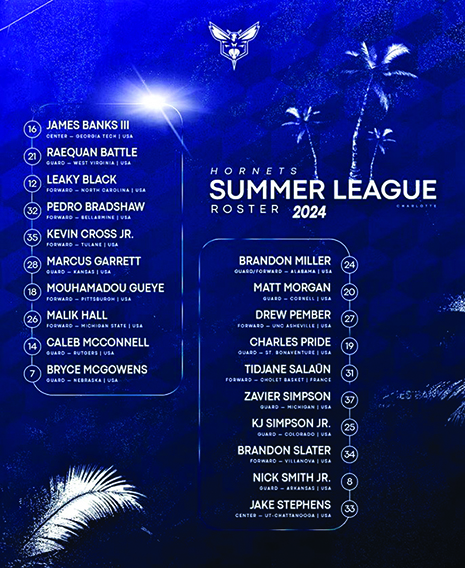
Dawning the classic white, purple and teal colors of the Charlotte franchise, he buzzed around the 3-point arc and stung San Antonio with his long-range marksmanship with four made 3-pointers. Against the Chinese national team his athleticism was on full display during two separate rim rattling moments, both resulting in an aggressive, two-hand jam.
“Knowing so many of our Tulalip youth are following Rae on social media and keeping note of the Summer League tv schedule so they can root for him from home is so special,” said RaeQuan’s mama bear, Jacquie Williams. “It brings so much joy to my heart because not being in a big metro area, like Seattle where Jamal Crawford, Isaiah Thomas, and others are examples of how life changing basketball can be, instead our kids have one of their own to be their hoops hero…they have RaeQuan Battle.”
Summer League Battle intends to maximize his time court time as competition moves to Las Vegas. Those wanting to tune in and catch him wearing the iconic Jerry West logo on his chest can find his upcoming games broadcasted on ESPN2 or NBATV.

The return of Shelly Lacy: Tulalip’s former CEO takes the helm at beda?chelh
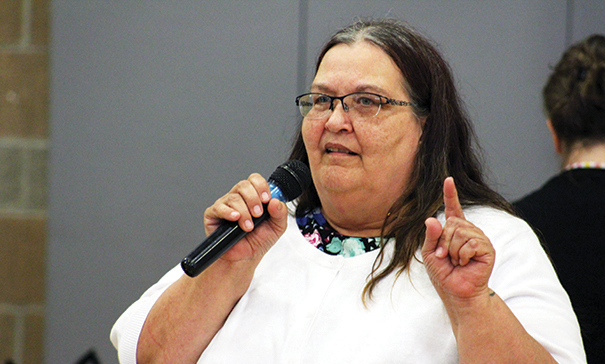
By Kalvin Valdillez, Tulalip News
Shelly Lacy is certainly a woman who needs no introduction. Her resume speaks for itself. However, we thought it was important to include one in this article, because we wouldn’t think of throwing our readers into a Q&A without any context.
During the final week of May, the Interim Executive Director of the Tulalip’s Family Advocacy department, Jade Carela, announced some exciting news through the Tribe’s governmental emailing system. That news was that Shelly Lacy was retiring from retirement and making a return to the Tulalip’s workforce as the new manager of the beda?chelh program.
Shortly thereafter, Tulalip News scheduled a one-on-one interview with Shelly. And through the interview, we were able to catch a glimpse of her brilliance as she passionately shared the love she has for the future leaders of the Tribe, as well as her desire to help keep families together and reunify children with their parents, if and when possible, while serving in her new position at beda?chelh.
We invite you to read the following transcription, a series of questions that are often raised within the community, and Shelly’s detailed, straightforward, and heartfelt responses. In turn, we hope you gain a little insight on what beda?chelh is, it’s function and operations in the community, and why it’s an important program for Tulalip children and families.
Why don’t we start with a little bit about your background – an intro to who are, who your family is…
My parents are Joy Jones Lacy and Cecil Lacy, my dad’s deceased. My grandparents were George and Louella Pratt. I belong to the Jones family. I had one brother and one sister. She’s Cecile “C.C.” Lacy Eastman. And then my brother was Cecil Lacy Jr. And I have one daughter, Joylee, and a new granddaughter, she’s a year old now.
You’ve had a big hand in shaping the Tribe and its future over the years, can you share a little about your career thus far, and why it’s important for you to work for your people and community?
When I first started working, I worked at the Bureau of Indian Affairs for 10 years; I worked in forestry, enrollment, and as contracting officer. I then came back to the Tribe as a health and social services administrator. I also worked in contracts and grants, and I’ve worked as the quality assurance privacy officer, as general manager.
Then I was principal at Heritage High School for nine and a half years. I came back to the Tribe as the beda?chelh manager for six months before I moved into the CEO position. And then I took a year off to be with my grandbaby and spend her first year with her.
My family has always told us that it is our job to get an education and come back to help our people. And because I held the beda?chelh job for only six months – it just felt like there’s still work to do here. There’s still work to do to support our social workers in our community.
Can you explain what beda?chelh is and the purpose it serves the community?
beda?chelh actually means ‘our children’ in our language. We are the child welfare agency for the Tribe. We do have CPS services, but we actually co-investigate with the State. So, the State does the investigation, and our social workers go with them. If it’s decided that a case will be open, we have ongoing social workers that then can take over the case. And all the cases are done in our tribal court.
We have foster care placement teams that are currently looking into licensing our tribal homes as foster homes. They also reach out to families to make sure that if we’re removing a child, that we try to find a family member to place them with. They do check-ins, home studies. And then they also check-in with the families to see what kind of support they need when they first get the kids. And then we have guardianships, so if our kids can’t be moved back home, then their long-term plan might be guardianship. And we have a team that supports the guardianship families as well.
There’s a bit of a negative perception in the community about beda?chelh, can you touch on that, and talk about what you envision the program growing into?
I think that the community has the perception that social workers take their kids. But really, beda?chelh does the investigation, and then presents it to the judge. The judge decides if the kids are going to be placed in home dependency and the parents get services, or if they’re going to be placed out of home while the parents get services. And so, I think that it’s just reminding people that beda?chelh is here to help.
For example, we had parents – one of their barriers was car insurance. We found resources to help them with that. First, with getting their car insurance and then also helping them budget. Sometimes, it’s those little things that are keeping the parents back.
We’ve also heard feedback from parents that they need more assistance. We’re looking at how to continue to grow our focus to help parents get the services that they need.
If reunification is possible, is that the ultimate goal?
Yes, reunification is always the goal. Because kids want to be with their parents. Our goal is always to try to provide whatever services we can to reunite the families. But, addiction, as we all know, is sometimes a hard disease to fight. And sometimes, it takes parents longer to win that addiction battle. Sometimes kids have to go into guardianship, because we just couldn’t reach that point with their parents to keep them safe yet.
Can you talk about the process and the steps that a parent would need to take in order to be reunified with their children?
Well, every case is a little bit different, because it depends on why the children were taken. The State and the Tribe do a co-investigation, and if the complaint is founded, that means that there’s enough facts to show that the children could be at harm, then the case is open.
The judge will decide to either do a safety plan and leave the kids in the home with the parents or if the kids are going to be removed from the home. If they’re going to be removed, then we have to have a family meeting to see if we can find family to place the kids with. And then we’re looking at what services do the parents need to get their kids back, but it all depends on why the kids were removed.
And then the case managers do active efforts – a lot of outreach to the parents, helping them get the services they need. And then, depending on their case, as they complete their services, we’ll move toward the process of setting up supervised visits with their kids, and then unsupervised visits, and then we’ll start working towards weekend visits. We start working on transitioning the kids back in the home. We want to make sure that as the kids are transitioned in the home, we are providing those wraparound services in the homes to help the parents have the support they need to get their kids back in their home.
You mentioned wraparound services, I know that beda?chelh works with a lot of different programs to bring services and resources to the families. Can you talk about the importance of those relationships and how it helps the families with an open case?
We do a lot of work with Family Haven, they have a lot of our FPS (family preservation services) and our wraparound services. That allows the provider to go into the home and really provide those one-on-one services that are geared to whatever the family needs. It might be ‘we need bins to help our kids keep their toys organized’, or ‘I need help getting my kids on a routine so that they’re doing their homework’. They can help with whatever the family needs. And that’s really useful because then it’s not that cookie cutter kind of services.
We work with family services, the health clinic, youth services, the tribal police department, housing. There’s a lot of departments that we work with to get whatever services are our clients need.
For those parents who are feeling overwhelmed right now what is the message that you’d like to share with them?
That I hope that they would take a breath and know that we’re here to support them. My door is open they can always call me if they need support. Call us and we can try to work through everything with you. And just know that we’re here as a resource for you, so please reach out to us.
How does it feel when the parents are finally reunified with their kids?
There’s lots of happy tears – there’s LOTS of it. It’s a hard emotion to explain, because we’re so happy that the kids get to be with their parents. You get to see the smile on their faces. You get to see how proud the parents are of themselves, because they’ve done a lot of work. I kind of don’t have the words for it. It just makes my heart feel really happy.
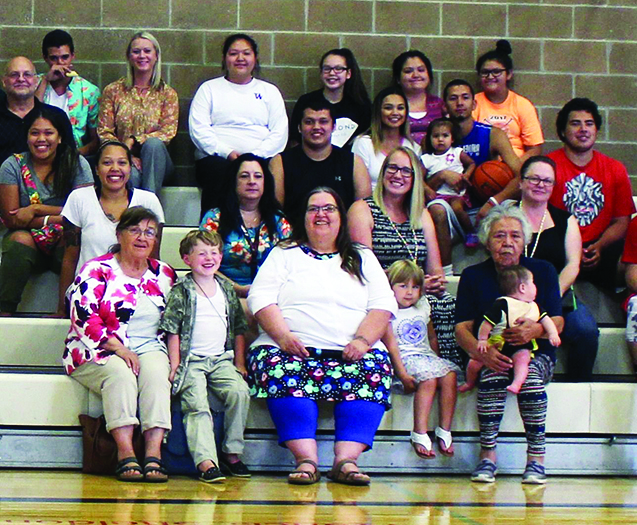
When a child does get placed in a home, does beda?chelh keep in contact with the kiddo and the placement family?
It really depends on which kind of placement. When they’re still in foster placement, and when the case is still open, we’re trying to reunify them with their parents. There’s a lot of intensive work that’s done with the family, with the parents, with the kids, and with the foster parents. Usually, once it’s decided that we can’t reunify and we’re moving towards the guardianship, for the first three years the guardianship team is really involved. After that, it’s more the family reaches out to us if they have an issue.
Part of my work will be looking at the code (Tulalip tribal codes Chapter 4.05 Juvenile and Family Code) and our policies to see are they up to date. And we’re going to start with guardianship and adoption. We’ll be asking for community input and having some community meetings around that so we can hear from people. Because when kids are in guardianship, we don’t terminate parental rights and the Tribe is still responsible for the children.
I think that we need to look at the code to see if we are able to continue to do yearly check-ins to see how it’s going. Checking-in with the kids and seeing if there’s anything that we can help them with. Just to let them know that we still love them, that we still care about them, that they’re still part of us.
Why is it important for the kids to stay with a family member or in the community?
Because they’re our kids. We want to make sure that they’re always a part of our community. They’re our resource. They’re our future. They’re the ones that are going to take care of everyone down the line. We need them here learning our culture, learning that they always have family that cares about them, and really to be wrapped in love by our community.
As the new beda?chelh manager, what are some things that you want to address right off the bat?
Like I mentioned, the code is really the major thing to start with, because all of our work comes from the code, from our policies to our SOPs for all of our positions. And then it’s really about looking at our code to see if it’s reflective of us as a community. Is it reflective of our cultural values? Because that guides the work that we need to do.
From there, we look at training our staff. Making sure our staff has the knowledge of who we are as Tulalip people, our values, why our kids are important to us, and how we treat our kids and our families.
Does beda?chelh host events or get togethers for the kids and families in the program?
Yes, our placement team has done a few in the past and we’re now looking to do an event night once a month. They’re doing cultural activities for our placement families; we’re looking at different projects like that – basket weaving, paddle necklaces, and we’ve talked about bone games or stick games. And we have a Christmas event every year. And because our employees and our community graciously sponsor our kids, they’re able to get extra special Christmases.
Why is it important to incorporate the culture and make sure that is still a part of their lives?
Because we want them to know where they come from. We don’t have as many kids in non-tribal homes as we have in the past, but we still have some. We also have some Tulalip families who might have just moved back home, and they might not have grown up here and might not know the culture all that well.
All the research shows us that if kids know where they’re from, they know their background. If they see people like themselves, they can feel that community love and they’re going to be more successful; they’re going to have less issues as they get older. We really want to make sure that our kids know who they are, that they can see us, they can connect with us. This is their community, and they always have a place here.
Now that you’re in this position, can you describe that feeling and what you’re most looking forward to the most?
I’m just happy to be here. Some of our staff that we have here now were actually my students at Heritage, so it’s nice that I get to see them at work. But for me, my family raised me to always give back to the community, that is our job. Just like it’s our job is to go to general council meetings, because we’re a member of this Tribe – that’s our responsibility. This is my responsibility. I’m here with my education and my experience to give back to my community. Education and our children have always been part of my passion. It’s good to be here, to be able to support our families in any way that I can.
For additional information about beda?chelh and the services that the program offers, please contact (360) 716-3284.
Boom City reflections
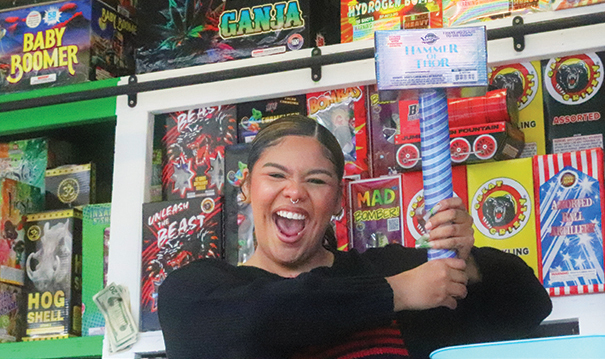
By Micheal Rios, Tulalip News
For more than forty years now, the Tulalip Tribes have transformed a vacant space on their sovereign land into an excitement fueled marketplace for those looking to satisfy the celebration demands of Independence Day.
Tens of thousands of prospective customers from all across the Pacific Northwest journey to the fireworks-filled Boom City every year seeking the perfect purchase. The most highly desirable family order typically consists of child friendly sparklers, Roman candles and snap poppers that accompany the thrilling sights and sounds of the more advanced pyrotechnics, like booming artillery shells and mesmerizing 500-gram, finale cakes.

Largely illegal in Washington State, the distribution and discharge of fireworks is permitted on the Tulalip Reservation as a direct result of tribal sovereignty. Snohomish County at large, including the surrounding cities of Marysville, Arlington and Everett, have instituted fireworks bans. However, those municipal and county government structures have no authority over Tulalip. Praise the Point Elliot Treaty!
Embodying that sovereignty are the 100 or so stand owners who create the always lively wheeling and dealing atmosphere Boom City is well known for. Each stand owner is a Tulalip entrepreneur looking to cash-in on 4th of July festivities while creating a loyal, return-customer base to add to Boom City’s lore.
Following another successful season, we caught up with a handful of those who best embody the entrepreneurial spirit and have grown up within and around the proud Boom City tradition. Each was asked three simple questions. What did you like this year? What did you dislike? And if you had the power to make a change for next year, what would it be and why?

Eliza Davis
Q. What did you like?
A. I like that we are able to have a lighting area to accommodate customers who are not able to light fireworks elsewhere due to bans in their towns or cities. Without the lighting area, I think we would have a definite decline in our business.
Q. What did you dislike?
I didn’t like that our layout. The rows and space for stand owners to A. set up is so uneven. We had some rows with way more space to put merchandise out in front of their stands and then other rows with a significantly less area to work with. The parking lot was also very uneven for those on the North entrance. There was a lot more available parking near the South entrance.
Q. If you had the power to make a change for next year, what would it be and why?
A. So one change I would like to see is finding a way to ensure equal parking on both entrances and that our layout is evenly spaced out. That way all stand owners have access to the same amount of area in front of and around their stands, as well as equal access to foot traffic from both ends of the parking lot.
One other thing I would like us to consider is aligning our fireworks code with our employment code for preference tiers 1-3. We have a lot of decedents who want the opportunity to work and they are not enrolled so they don’t get the opportunity unless their parent has a stand. It makes sense to look at this code through the employment code preference tier from 1-3 to me. These folks live in our community, impact our economy, and many give back to our community.
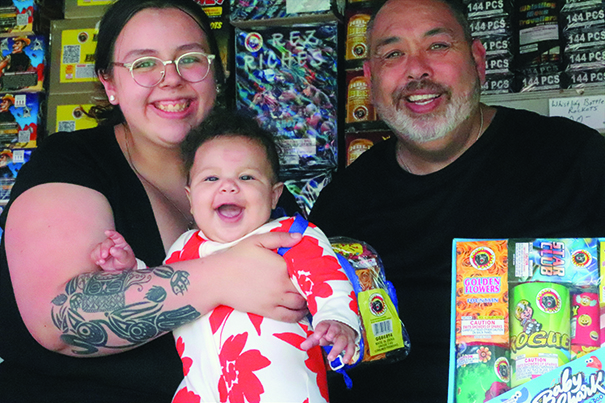
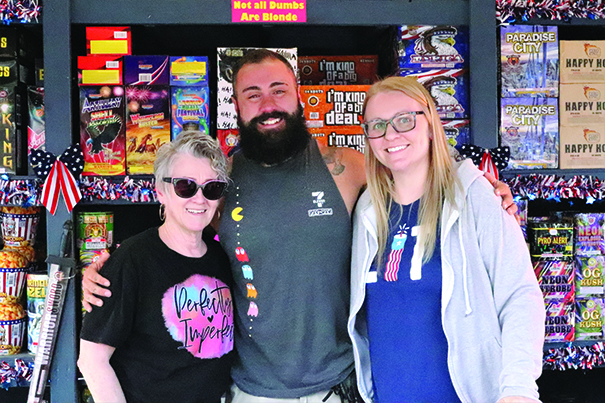
Krislyn Parks
Q. What did you like?
A. I love the community of beautiful Natives coming together to make a living for their family by using our sovereignty and selling people fireworks to celebrate with their friends and family!
Q. What did you dislike?
A. I personally didn’t like that my customers walked around all the bathrooms that were supposed to be open for public use that had locks on them. They couldn’t go to the bathroom, but were sold food and drinks. I don’t understand why our people put locks on free bathrooms. It was really sad to watch kids pee their pants and elders freaking out not being able to use the restroom.
A. If you had the power to make a change for next year, what would it be and why?
Would probably be to have more or better transparency of all aspects because too much is left unsaid and secretive. But also, our customers need bathrooms so let’s start with that.

Wade Sheldon
Q. What did you like?
A. I liked being there, and being able to hang out with friends and relatives I don’t normally get to see.
Q. What didn’t you like?
A. I don’t like how more and more cities are cancelling people being able to light off fireworks by imposing bans, issuing citations, and making it illegal.
Q. If you had the power to make a change for next year, what would it be and why?
A. I would have all of Boom City lean more into safety. I think that a lot of people buy these fireworks and don’t give them the respect they need. We need to show people how to properly respective fireworks by showing how to handle and light off correctly. By creating safety videos and offering a fireworks safety class at Boom City, we could get more families to come up and more customers for every stand. The more we prepare for the future, the longer we will be able to keep selling fireworks at Boom City.

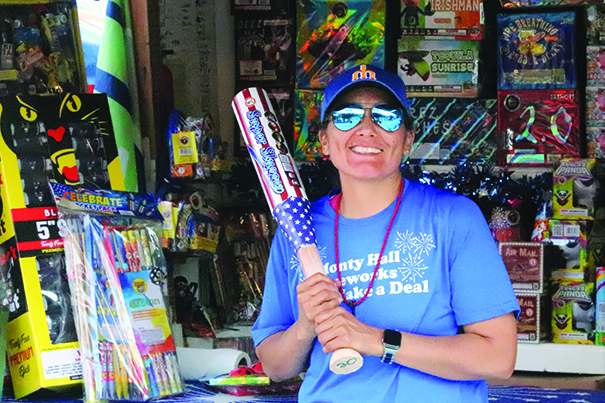
Sabrina Moses
Q. What did you like?
A. I love the family time I get. It’s our dad and auntie’s business, Monty Hall Fireworks. To be able to come together every year as a family and Tribe is a blessing to me. This year, it was my brother Brandon Moses, my dad Jon Moses, my nephew Brayden Moses and a family friend Bruce Mosqueda who all worked the stand. I am very happy with this year’s results.
Q. What did you dislike?
This year, I dislike that it was shorter selling season. We rely on all the days we can get.
A. If you had the power to make a change for next year, what would it be and why?
I think all stand owners should have to show up to the Boom City meetings they have each year.
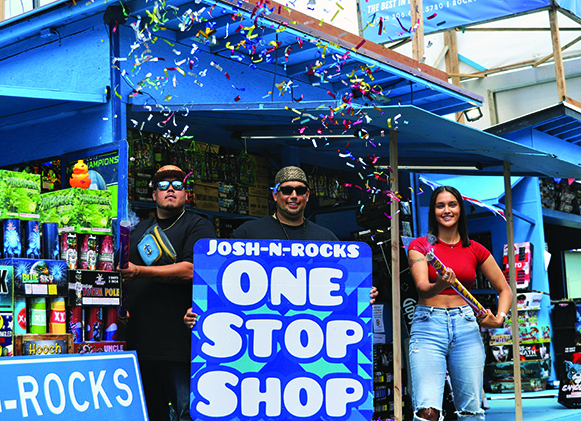
Josh Fryberg
Q. What did you like?
A. What we liked about Boom City was friends and family coming together and helping keep family traditions alive. I remember working Boom City with family when I was just 7 or 8 years old. There are a lot of great memories for so many. We are looking forward to more of our kids being more involved, learning the business side of fireworks, and passing on what they’ve learned to their kids one day.
Q. What did you dislike?
A.We disliked the weather. There was a lot of rain this year leading up to the final week.
Q. If you had the power to make a change for next year, what would it be and why?
A. If we were able to make one change, it would be to have a few meetings with our Tulalip Board of Directors, Boom City committee and stand owners, so we all come together in a good way and create solutions that benefit all of us.
June 29, 2024 syəcəb
Use the following link to download the June 29, 2024 issue of the syəcəb
TELA students take part in clambake
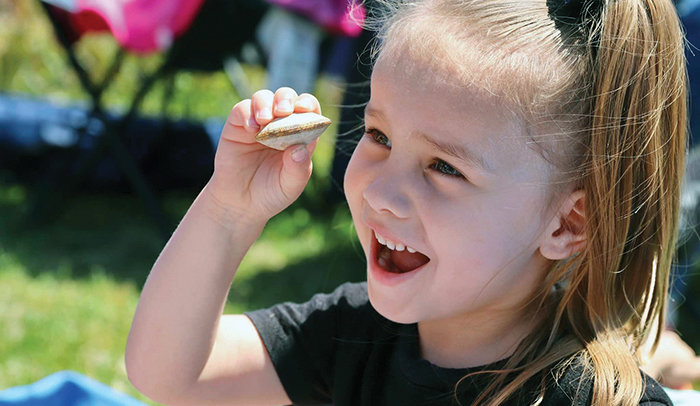
By Kalvin Valdillez, Tulalip News
“At Tulalip, our people lived all along the water in the village all around here,” explained Tulalip elder and historian, Ray Fryberg Sr., to a group of future leaders. “Our people gathered clams and cooked them right on the beach, using the fire, water, and the steam and all of these elements to cook the food. And so, we’re going to have this clambake, the way our ancestors used to cook the food a long time ago, when they lived here and traveled in canoes. I know in school you learn about our culture, you hear stories, you hear the language, the words our people spoke and that’s really important. Today, you’re going to enjoy some of the foods that belongs to us from this area.”
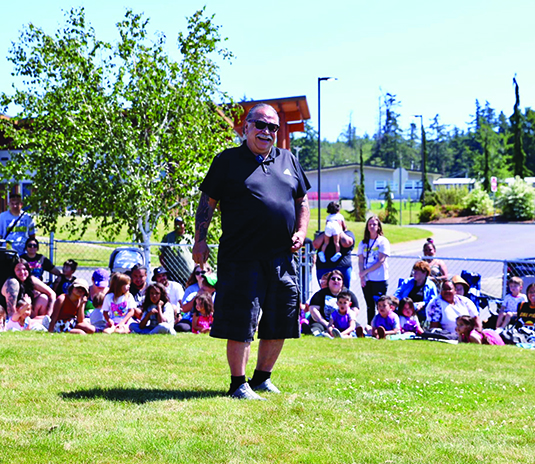
On the gorgeous morning of June 21, the young learners of the Betty J. Taylor Early Learning Academy ventured outdoors to a small field overlooking Tulalip Bay to engage in a fun and significant tradition of the Tribe. As the kiddos entered through the gates of the TELA field, they couldn’t help but marvel as steam rose into the air from a cinder block fire pit. Inside of the pit, hundreds of clams cooked slowly to perfection as the aroma of a traditional Tulalip meal filled the air and carried in the breeze throughout the Academy’s campus.
Said TELA Director, Sheryl Fryberg, “We’re so excited about our third annual clambake. It’s such a blessing to be able to share with our children, our birth to five children, and their families this way, our traditional way of life. This year we actually added salmon and oysters to further their experience with our tribal traditional food. When I was going around and asking the children to come up to the pit, so they can look at the clams, they were really excited. They were all excited to have clams again.”
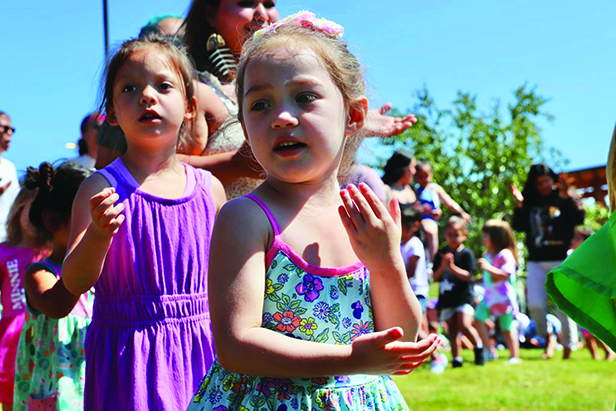
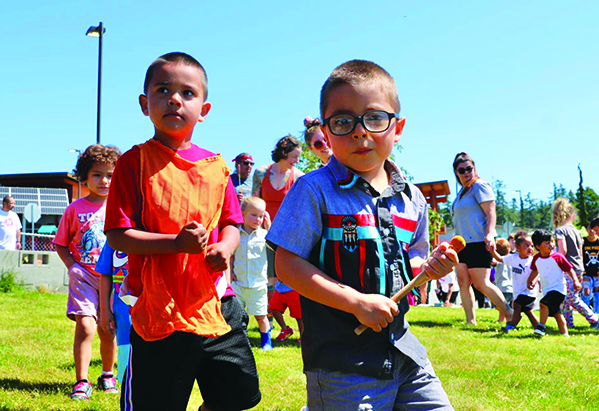
After the students found a spot to sit in the grassy field and enjoy the sunshine, Ray took the opportunity to share a traditional story about the beaver, a story passed down to him from Raymond ‘ti-at-mus’ Moses. Ray had their full attention throughout the story and had many kids laughing as they learned how the beaver got its flat tail.
While Ray shared the story, Tulalip culture bearers and brothers, Thomas and Andy Williams, were on cooking duty and tended the clams. Three years ago, when the annual clambake made its original debut at the Academy, Ray passed down the knowledge of how to prepare and execute this traditional method of cooking to Thomas and Andy. Since then, they have put that knowledge to use and have prepared the clams each year since, and plan to continue to do so for the foreseeable future.
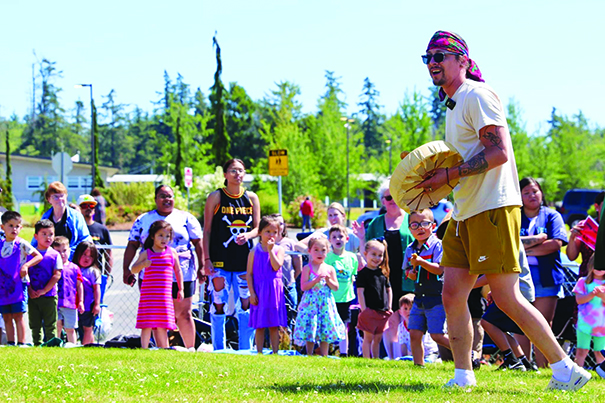
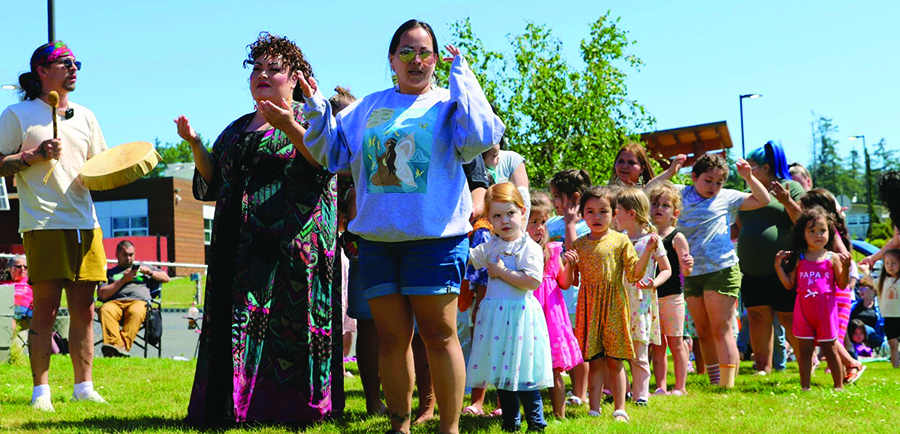
The clambake is a joint project between TELA and the Lushootseed department. Over the years, the two departments have forged a strong relationship. Working together, they have developed and implemented a cultural immersion program that introduces Tulalip’s ancestral language to the Tribe’s membership at a young age, during the critical era of early childhood brain development. Each school day, Lushootseed language warriors visit the Academy’s classrooms to impart traditional words, phrases, songs, and stories to the kids, ensuring that the language revitalization continues to thrive generations from now. In addition to helping organize the event and set up the space for the gathering, the Lushootseed language warriors also harvest essential resources needed for the clambake.
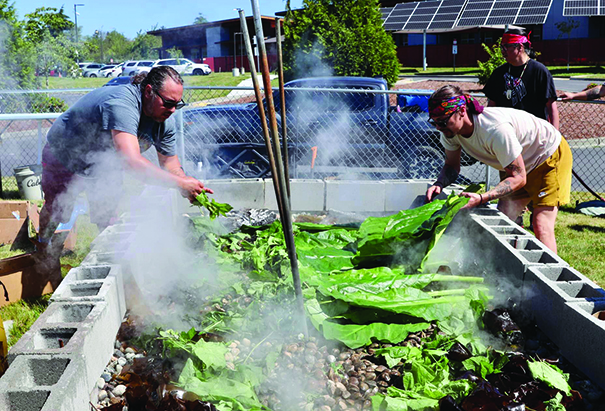
“It’s a lot of work, a lot of preparation,” shared Thomas. “It can be stressful, but when we get here and we see it all work out, it feels really good. It helps us realize that even though it seems challenging to do this style of clambake, it’s worth it when we see the kids have the experience that they’re having, because none of us experienced anything like this when we were in school. Three years ago, Uncle Ray told us everything we needed – the first thing we have to get is kelp and we have to make sure the tide’s right because it’s got to be low enough to get the kelp. Me and my coworkers from the language department went to Camano Island State Park for the kelp. Then we went to Sultan to get the thimbleberry leaves and skunk cabbage leaves. And obviously, we could get those down here, there’s some by the admin building, but that stuff’s not clean. So, the higher we go up, we alleviate that question of ‘oh is this stuff clean?’. And TELA’s able to order the clams and get the firewood, so that’s basically the essentials for the clambake.”
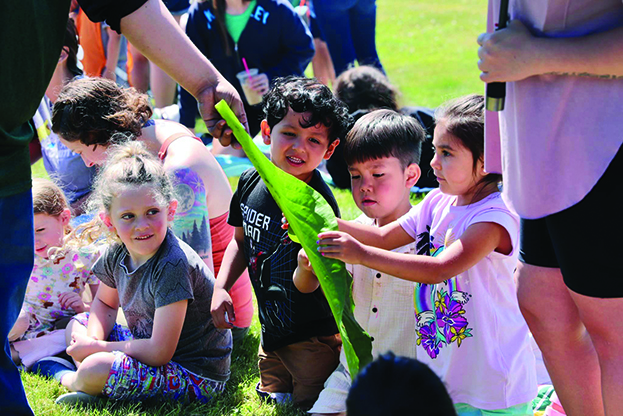
He continued, “This is important because they get to eat it and enjoy it, and it’s so much fun for them because it’s an outside activity. But they’re actually eating stuff that’s really healthy for them. They’re eating stuff that they’ll be able to harvest themselves one day, and they’ll have that understanding of food sovereignty. This is important to pass on because we didn’t really have this experience as kids, but now that we know, we’re able to fill in that gap. Every generation will fill in that gap. It’s resparking that historical knowledge. This is just one step. We’re preparing clams, but there’s a lot of resources that need to be harvested to do so. When we do the clambake, they also get to learn about kelp, thimbleberry leaves, skunk cabbage leaves. So, we might be just feeding them clams, but they’re learning holistically a bunch of our traditional ways that ties it all together.”
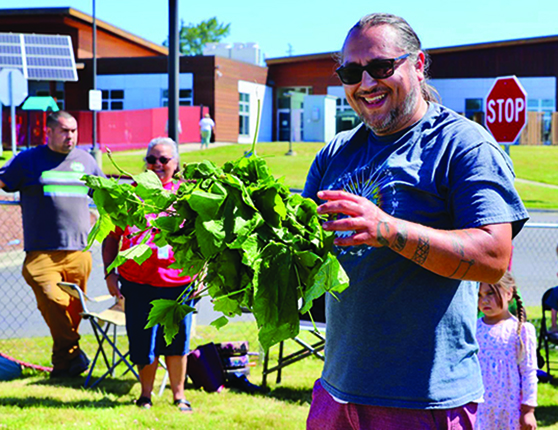
As the clams continued to steam beneath layers of kelp, thimbleberry and skunk cabbage leaves, the kids happily joined together in song and dance alongside their teachers from both the Academy and the language department. When the clams were ready, they were uncovered and scooped out of the pit. Each student received their own tray of clams and oysters, which was also accompanied by frybread and salmon, and it was all smiles as they grubbed down on the shellfish with their peers, teachers, and families.
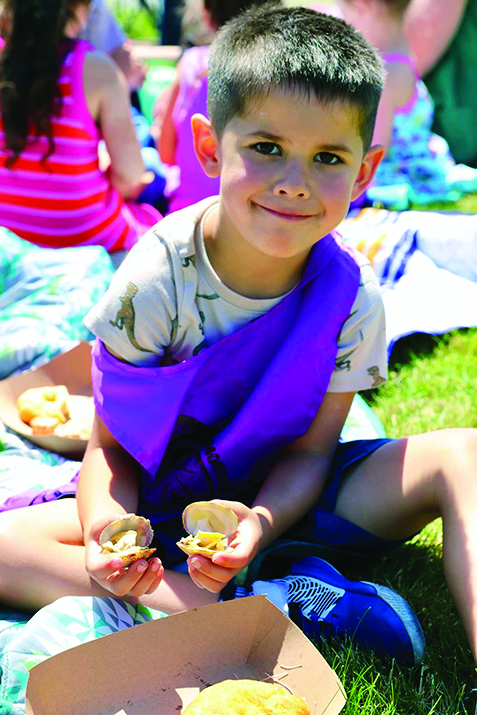
“My heart almost exploded with joy and happiness when I watched them eat their clams and salmon,” Sheryl expressed. “It’s a beautiful thing to see them have this experience. I feel blessed that we’re able to partner with the Lushootseed department to do this for the kids. We’re so grateful to all the people who we were able to accomplish this with. We had a lot of families come this year, and that’s what it’s all about – experiencing this with their kids. And it’s also about sharing the traditional songs, the language, and the stories with the children and their families. It’s so beautiful because they’re continuing to grow in their culture and spirituality.”
Vibrant vibes at student coastal jam
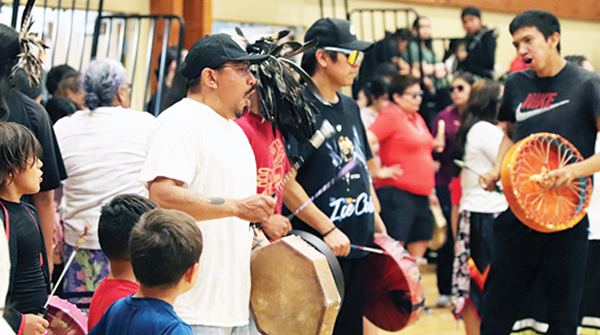
By Wade Sheldon, Tulalip News
On June 18, the Don Hatch Memorial Gym was filled with the vibrant individuality of Tulalip students and their families, making the End-of-Year Coastal Jam a memorable event. This community-driven gathering was a testament to the unique dancing styles and regalia that are the hallmarks of our culture. It was a master class, with the next generation of culture bearers showcasing their knowledge of our traditional dances and songs, while celebrating their academic achievements and welcoming summer.
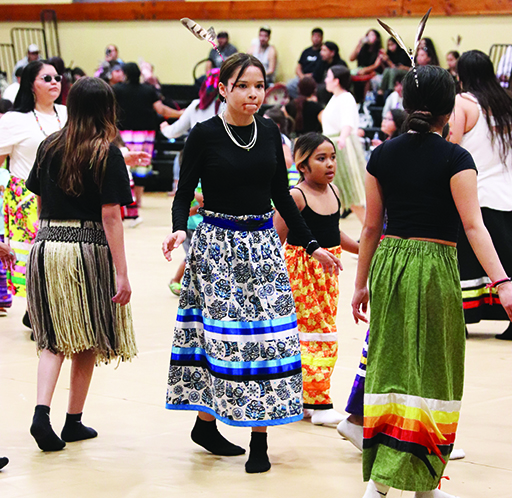
Coastal jams, a celebration of our Coast Salish tradition, are more than just a showcase of artistic expression, they’re a vital gathering that weaves the threads of our community bonds and cultural pride even tighter.
As coastal jam participant Kaylikwa Fryberg eloquently said, “These events mean everything; the joy of gathering and being together is special. I cherish events like this and hope everyone else does too; our entire culture means so much to me. Now that school is over, I will be going to Lushootseed camp, where I will learn the language and tell stories.”
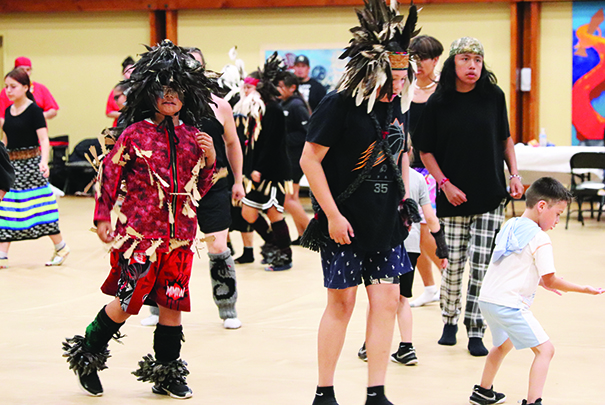
Among the dancers were also several drummers and singers, including Image Enick, who said, “It’s important for our younger ones to have a safe place to gather and see their family and participate in their culture. At the same time, we can connect with our ancestors and carry on the traditions of our people. To be able to gather here to do this, is reviving what we lost years ago due to the boarding school. This is a big example of our way of life and how we Coast Salish people live. Our dances and these songs tell the stories.”
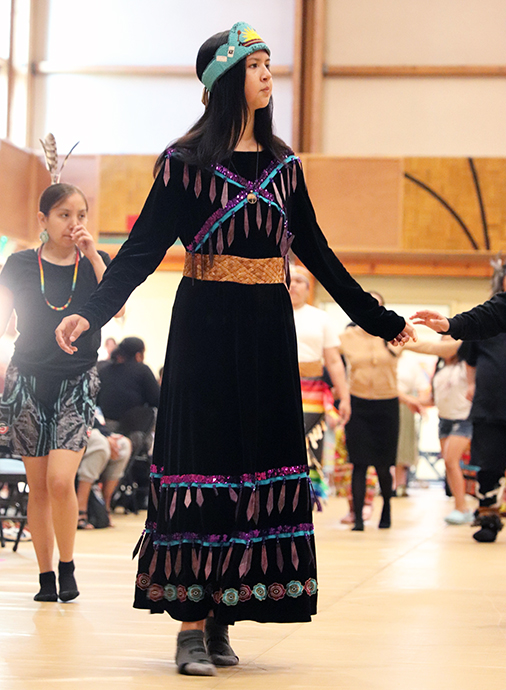
When asked what his favorite part about singing and drumming is, Enick replied, “It’s a blessing to be able to give back and share good thoughts and prayers. It warms my heart to pick up my drum and share it with the community.”
Blending vibrant celebration with profound significance, the gathering marked the end of another school year and provided a vital space for our youth to connect with their culture.
Graduates radiate achievement on summer solstice
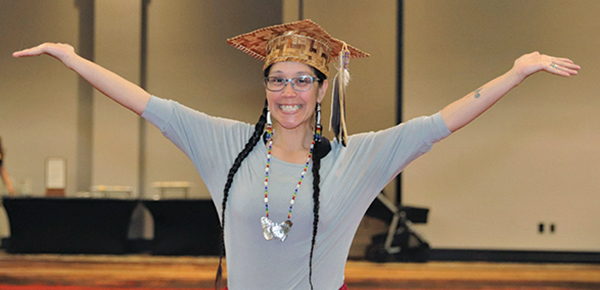
By Micheal Rios, Tulalip News
Every time a Tulalip graduates from a university, community college, or vocational school, they instantly become the living embodiment of what it means to reclaim a narrative. For so long, our people were shut out of academic environments where they could share their truths, where they could proudly embody the vibrant traditions and teachings of their thriving Coast Salish culture.
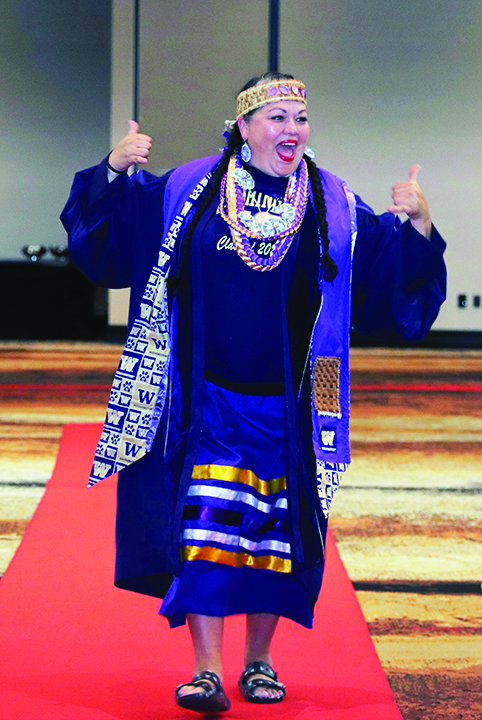
Previous generational barriers to equitable education access ultimately helped proliferate the unfortunate, yet still prevailing, narrative that says we can’t succeed within a westernized education system. United States census data supports this misguided narrative by showing that while more than 65% of high school students attend college, only 19% of Native American choose to do so. In an era where education is a critical cornerstone for self-sufficiency and quality of life, only 13% of tribal citizens age 25 and older hold a college degree.
These statistics and others may attempt to draw a bleak conclusion in regards to our people and education, but the truth is, more than ever before, we are seeing the narrative reclaimed and rewritten by present-day Tulalip scholars. This generation is actively pursuing all levels of college degrees at a historical rate. In doing so, they are intentionally decolonizing educational pathways for their peers, their children, and for future generations who will have shining example after shining example of Tulalips strutting across a graduation stage and proudly receiving their hard-earned Associate’s, Bachelor’s, Master’s, or Doctoral degree.
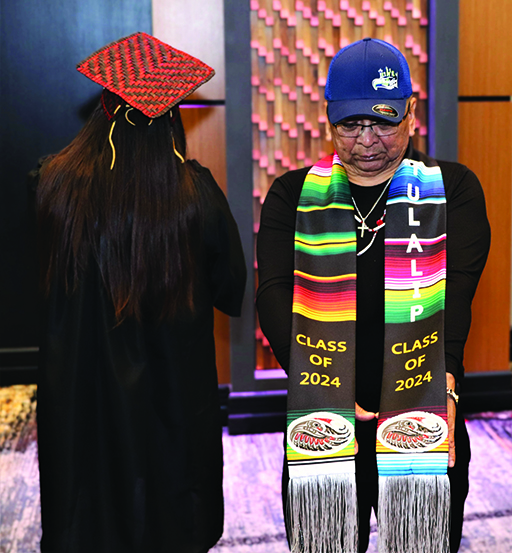
This culturally-led reclamation process was on full display during this year’s summer solstice. The astronomical first day of summer coincided with a special banquet that recognized the amazing efforts of fifty-seven Tulalips in their pursuit of higher education.
“You’ve all put in so much hard work and countless hours of studying to earn your degrees. We are so proud of you for choosing to better yourself, your community, and your future through education,” said Chairwoman Teri Gobin during her opening remarks. “As a tribe, we know we need to be better at utilizing your brilliant minds and supporting our college graduates. As we continue to grow our business operations and evolve as a tribal government, we want you to feel welcome to build a career with us.”
It was a powerful moment when the words washed over the graduates as they sat with their support system of family and friends in the Tulalip Resort’s Orca Ballroom. It’s the hope of Tulalip leadership that many of the graduates will consider finding their professional homes within the Tribe’s vast enterprise.
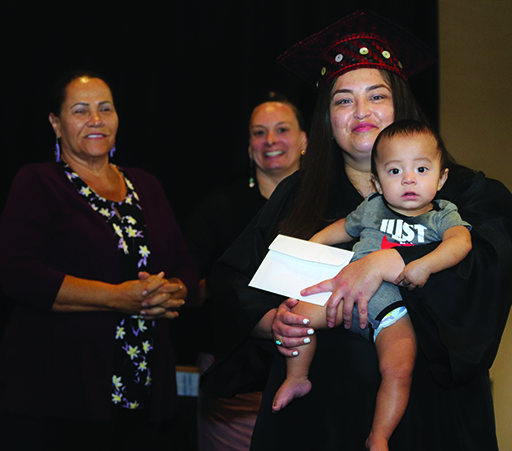
Several college grads being recognized on this evening had been diligently carving meaningful roles in their traditional homelands for years now. In fact, of the six Master’s degrees and one legendary Doctoral degree celebrated this year, all but one of these inspiring tribal members are well established within the Tulalip Reservation as a professional in their field. Furthermore, all of these collegiate trailblazers are women. Together, they radiated not only all the achievement vibes, but that unique matriarchal energy that comes from a deep and sincere lived desire to better themselves, their families, and their shared tribal community.
Each of the attending Master’s degree wielding matriarchs were willing to share a little insight from their collegiate journeys and heartfelt words of encouragement.
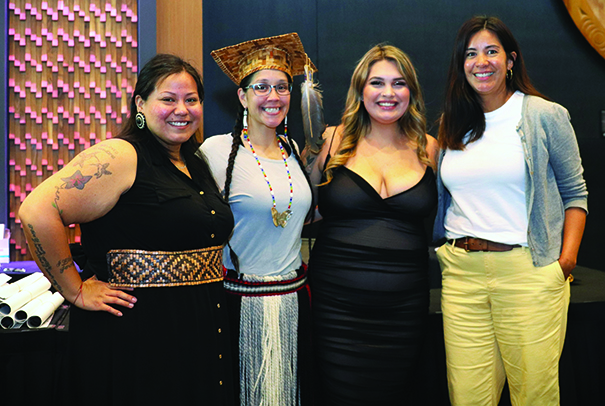
Chelsea Craig *Doctor of Philosophy* – Quil Ceda Tulalip Elementary assistant principal.
“My biggest motivation has always to been to honor my great-grandmother Celum Young who was a survivor of the Tulalip Boarding School. I like to think that this achievement brings healing to her spirit because we weren’t supposed to be here today. None of us were supposed to be here in 2024 as full, intact Coast Salish people. They tried to do everything within their means to destroy my great-grandmother’s identity, and her experience is what set the tone for me and my path.
“Looking forward, I hope that I’ve opened pathways for even more Tulalips to strive for a college degree. If I can do it being a full-time educator and a mother of four, then so can so many more of our people. Beyond that, I want our people to know they are capable of great things without having to lose themselves in the process. Each stage of my educational journey I never compromised who I was as a Tulalip. From how I wrote my papers and who I sourced, I was very intentional about quoting our ancestors and wisdom warriors. I hope people furthering their education are conscious about centering their culture always. Take it, claim it, and own it. That’s how we embody our sovereignty.”
Natasha Fryberg *Master of Arts* – Hibulb Cultural Center rediscovery manager
“I’ve always looked at education as a priority in life. Being a first-generation college graduate in my family is so meaningful to me because it proves to my siblings and children it can be done. Already, two of my sisters are back in school to get their Associates degrees. Being that role model for my family and my community furthers my belief that anything is possible if you manage your time right and prioritize what’s truly important to becoming your best self.”
Summer Hammons *Master of Arts* – Treaty Rights legislative policy analyst
“Ever since I was a little girl, my mom has been my role model to show me what’s possible when you dream big. She’d be working three different jobs and still be taking college classes because she was determined to earn her Ph.D. With each degree she earned, she utilized them towards her positions to better her people. She instilled that value in me to the point that now I play on continuing my education in pursuit of joining my mom as another Dr. Hammons.
“Something I try to remember always is just how much the Tribe invests in all its members who decide to attend college. It’s really expensive and we are so fortunate to be members of a tribe that prioritize education. On the hardest of days, when I’m lacking in motivation, I think of having the support of the Tribe and all those who laid the foundation for us to have this incredible opportunity. That intentionally drives my passion to be successful, and I hope it does for others, too. We each have a Tribe’s worth of support and investment backing us on our educational journeys.”
Josie Marchesi *Master of Clinical Health Services* – Health Clinic physician’s assistant
“I always intended to further my education in service of Tulalip. Growing up in Ellensburg, I was always so far from the community and our culture. But receiving my degree in health services allowed me to seek employment at the Tulalip Health Clinic. I was fortunate to be offered employment there in January of this year. Now, I am home serving the community. There is a lot of mistrust among our people and the health system because of so much bad history, and I want to be part of the solution in building that trust back.”
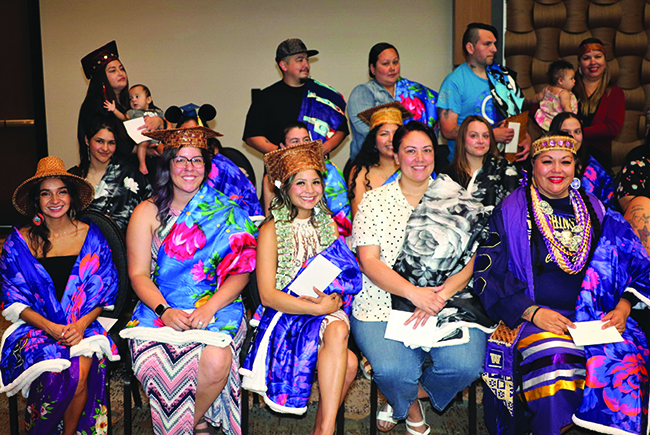
Lindsey Watkins *Master of Science* – Tulalip Tribes internal marketing manager
“It was always my intention to go back for my Masters degree after getting my Bachelors in 2007, but the timing never seemed right. Next thing I know I had two kids and was working at the casino. At a certain point, I realized if this was something I really wanted then I just needed to do it. So, I did. I’m glad to set that example for kids so that when they are older and if they choose to pursue a college degree, then I can tell them with confidence that they can do it. It’s going to take time, effort and sacrifice of fun things they’d rather be doing, but it’s 100% achievable.”
Brianne “Breezy” Distefano *Master of Arts* – Quil Ceda Tulalip Elementary kindergarten teacher
“I am proof that a high school dropout can become college graduate…a Master’s degree graduate at that. It’s funny looking back because I always knew that I wanted to be a teacher even though my own educational experience was very challenging. Add in being a mother of three and I can sincerely say I never thought this day would actually get here, but now that it has I am so proud of myself for never giving up. My kids have watched me through this whole journey, even coming to class with me at times. They know now what’s possible and that’s something that drives me as the only Tulalip teacher at Quil Ceda Elementary. I want all our kids to dream as big as they can dream.
“For any Tulalip out there, who didn’t get to walk with their classmates at graduation or hasn’t earned their diploma, yet, I want you to know that this moment doesn’t define you. You are all capable to success no matter how you choose to define it. All successes come by way of setting simple goals at first and as you achieve them, you can then begin to set bigger goals. No matter what happens or where life takes you, please remember that you are so capable of greatness.”
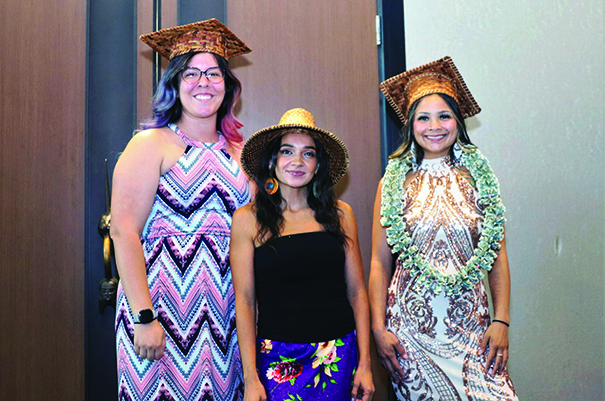
The higher education class of 2024 included seventeen Associate’s degrees, eight Bachelor’s degrees, six Master’s degrees, and one Ph.D. receiving, newly minted doctor. Fifteen vocational diplomas and ten high school diplomas rounded out the 57 Tulalip honorees.
Tulalip Higher Education staff are eager to help new and returning students find their path to academic success. They can assist with FAFSA applications and finding scholarship opportunities, as well as simply reviewing the Tribe’s current policies regarding paying for college and other educational programs. For those Tulalip citizens feeling empowered to help reclaim our educated Native narrative, don’t hesitate to get in touch with Higher Education at (360) 716-4888 or email highered@tulaliptribes-nsn.gov
Sheila Nadine Price
May 30, 1957 -June 15, 2024
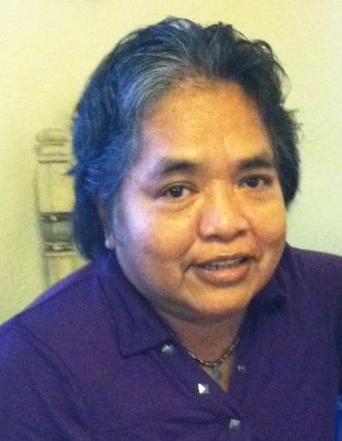
Sheila Nadene Price was Born May 30, 1957 and went to be with the Creator and her Family on June 15, 2024.
Sheila lived in her Tribal Community at Tulalip for most of her life. She attended school in the Marysville School District. Sheila’s chosen spiritual path was as a Full Gospel Shaker member as her parents and great grandpa Jimmy Price were.
Sheila had three beautiful children that she loved very much through all of the trials and tribulations in life. She wanted what was best for them. Every time her namesake came over she was sending her home with all kinds of food to make sure her needs were met.
Sheila loved Wolves and was always looking for pictures and nick nacks for her home. They were displayed throughout her home. She loved listening to all genres of music as you could tell from her large cd collection. Game Shows were a favorite past time.
Sheila loved playing the slots and being at the Casino. Thank you to all of her family and friends that provided transportation to her favorite spots. She loved seeing all of her family and friends at the casino.
Sheila leaves behind: daughters Sheila Perez (Polo), Josie Gomez, Son Tony Williams, 9 Grandchildren, brother Gary Price, several Nieces and Nephews.
Sheila was preceded in death by: her Grandparents Eugene & Minnie Joseph, Jimmy & Mary Price, parents Bill and Elsie Price, sisters Leota, Della, Cora, Bernadine, Rhonda, brothers Raymond, Larry, Michael and granddaughter Diamond.
A celebration of life for Sheila will be held Thursday, June 27, 2024 from 10:00 AM to 12:00 PM at Schaefer-Shipman Funeral Home, 804 State Ave, Marysville, WA 982704237.
June 22, 2024 syəcəb
Use the following link to download the June 22, 2024 issue of the syəcəb